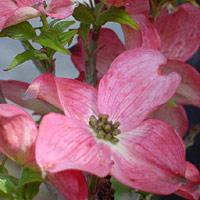Dogwood

The beloved flowering dogwood tree, found in home gardens across the country, is just one of the many types of dogwoods. Some species are native to the United States.
About This Plant
The most common dogwood,
Cornus florida , is a flowering tree that grows 20 to 40 feet tall and wide at maturity. Flower colors include pink, red, rose, and white, depending on the variety. Unfortunately, it is susceptible to a number of insect and disease problems, especially in recent years. Look for disease-resistant varieties, or consider planting Kousa dogwood (
C. kousa) instead. The most common shrub dogwoods vary in size from 6 to 20 feet tall and wide depending on species and variety. There is a spreading, ground cover form that only grows 3 to 9 inches tall. Some dogwoods have colorful bark -- yellow, red, or orange -- providing winter interest. Most dogwoods bloom in early spring to midsummer, depending on the species. Many produce fruits that are ornamental and provide food for birds. Hardiness varies among dogwoods, so use care when choosing plants.
Special Features
Four-season interest
Site Selection
Select a site with full sun to light shade and moist, well-drained soil. Some species prefer an acidic soil.
Planting Instructions
Plant in spring or fall. Space plants 6 to 20 feet apart, depending on the expected mature size of the plant. Dig a hole only as deep as the root ball and 2 to 3 times as wide. If your soil is in very poor condition, amend the soil you've removed from the hole with a small amount of compost. Otherwise don't amend it at all. Carefully remove the tree from the container and set it in the hole. Fill in around the root ball with soil until the hole is about half filled. Then firm the soil and water thoroughly. Fill the hole with the remaining soil and water again. Form a raised ridge of soil around the outside edge of the hole so it acts like a berm to help hold in water.
Care
Apply a layer of compost under the tree each spring, spreading it out to the dripline (the area under the outermost branches). Add a 2-inch layer of mulch to retain moisture and control weeds, keeping mulch a few inches away from the tree trunk. Water plants during the summer if rainfall is less than 1 inch per week. The trees require little pruning once established. In late winter, remove dead, diseased, and broken branches, and prune lightly to maintain shape.






 The beloved flowering dogwood tree, found in home gardens across the country, is just one of the many types of dogwoods. Some species are native to the United States.
The beloved flowering dogwood tree, found in home gardens across the country, is just one of the many types of dogwoods. Some species are native to the United States.